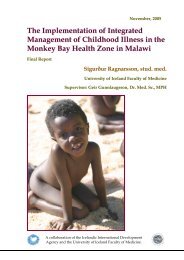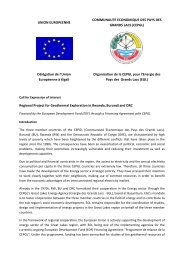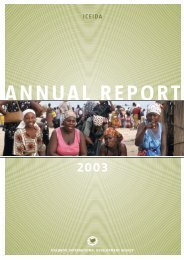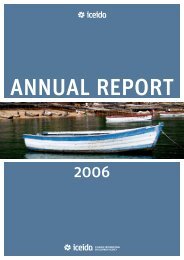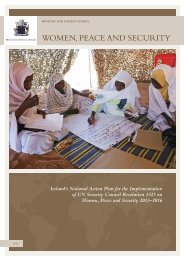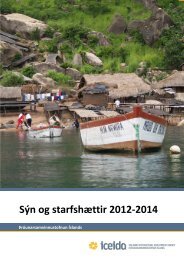Mangochi-ICEIDA-Partnership-in-Public-Health-2012-2016-Part-II ...
Mangochi-ICEIDA-Partnership-in-Public-Health-2012-2016-Part-II ...
Mangochi-ICEIDA-Partnership-in-Public-Health-2012-2016-Part-II ...
You also want an ePaper? Increase the reach of your titles
YUMPU automatically turns print PDFs into web optimized ePapers that Google loves.
MANGOCHI <strong>ICEIDA</strong> PARTNERSHIP IN PUBLIC HEALTH – PROGRAMME DOCUMENT <strong>2012</strong>-<strong>2016</strong><br />
2.1.2. <strong>Health</strong> Services Level<br />
<strong>Mangochi</strong> District is divided <strong>in</strong>to n<strong>in</strong>e Traditional Areas (TAs). This programme will use a division <strong>in</strong>to<br />
five health zones: Chilipa, Makanjira, <strong>Mangochi</strong>, Monkey Bay and Namwera. A health zone does not<br />
reflect a true adm<strong>in</strong>istrative level but rather the District <strong>Health</strong> Management Team (DHMT) uses this<br />
division for the purpose of strengthen<strong>in</strong>g health services plann<strong>in</strong>g and management.<br />
The DHO coord<strong>in</strong>ates all health services <strong>in</strong> the district and its vision is to promote the health and<br />
wellbe<strong>in</strong>g of all the people of <strong>Mangochi</strong> through an efficient and effective system of health care<br />
delivery. Its mission statement is to provide a comprehensive range of quality and equitable<br />
promotional, preventive, curative and rehabilitative health services. The ultimate goal of the DHO is<br />
to raise the health status of the population by reduc<strong>in</strong>g the <strong>in</strong>cidence of illness and premature deaths<br />
<strong>in</strong> the population.<br />
The district provides health services through a three level health care system as follows:<br />
<br />
<br />
Level A (primary/community): This is a health post which is managed by community health<br />
workers (health surveillance assistants, HSAs) who function as a l<strong>in</strong>k between the community<br />
and the health system and report to the health centre. A health post covers a number of<br />
villages with an average catchment population of 2,000. Each health post offers a number of<br />
services <strong>in</strong>clud<strong>in</strong>g simple diagnosis and treatment of m<strong>in</strong>or ailments, health education,<br />
sanitation, hygiene, disease prevention and control (such as immunisation, growth<br />
monitor<strong>in</strong>g and contact trac<strong>in</strong>g). <strong>Health</strong> posts are particularly important <strong>in</strong> treatment of<br />
diarrhoea <strong>in</strong> young children. Outreach cl<strong>in</strong>ics provide services rang<strong>in</strong>g from family plann<strong>in</strong>g,<br />
antenatal care, immunisation, growth monitor<strong>in</strong>g and health education. A team of health<br />
workers (medical assistant or nurse with 2-3 HSAs) goes out and conducts a cl<strong>in</strong>ic <strong>in</strong> a health<br />
post, a school, a church or even under a tree. Recently, simple but permanent structures<br />
have been constructed for this purpose <strong>in</strong> a few places. An example is the Chiumba<br />
M´basulea outreach cl<strong>in</strong>ic. This is a simple structure, two rooms and an open area (covered).<br />
Four HSAs come there regularly to conduct cl<strong>in</strong>ics. F<strong>in</strong>ally, the term village health cl<strong>in</strong>ic refers<br />
to HSAs conduct<strong>in</strong>g cl<strong>in</strong>ics <strong>in</strong> hard-to-reach areas. They do this <strong>in</strong> coord<strong>in</strong>ation with health<br />
centres.<br />
Level B (primary/health centre): A health centre covers a wider area constitut<strong>in</strong>g a number of<br />
health posts. Each centre provides managerial functions of health services <strong>in</strong> its catchment<br />
area. A health centre is designed to provide services to a population of 10 thousand but <strong>in</strong><br />
<strong>Mangochi</strong> today this ratio is usually exceeded and a health centre commonly serves 20<br />
thousand to 25 thousand people or even more. A health centre provides primary curative<br />
and preventive care, which <strong>in</strong>cludes diagnosis, treatment, immunisation and growth<br />
monitor<strong>in</strong>g (U5 cl<strong>in</strong>ic), micronutrient supplementation, maternity and family plann<strong>in</strong>g<br />
services, health education, and hygiene and sanitation promotion. Not all NGO centres<br />
provide family plann<strong>in</strong>g services, however. Staff<strong>in</strong>g level norms for a health centre specify<br />
two cl<strong>in</strong>icians (that is, doctors, cl<strong>in</strong>ical officers or medical assistants), two nurse/midwifes<br />
and one environmental health officer/health assistant (HS-POW, Tec.Rep.No 2).<br />
At each health centre there is a <strong>Health</strong> Centre Advisory Committee and its composition<br />
<strong>in</strong>cludes the health workers from the health centre and members of the community. The<br />
HCAC ensures that communities receive the services that they expect <strong>in</strong> terms of quantity<br />
and quality through monitor<strong>in</strong>g of performance of health centres <strong>in</strong> collaboration with VHCs.<br />
15








